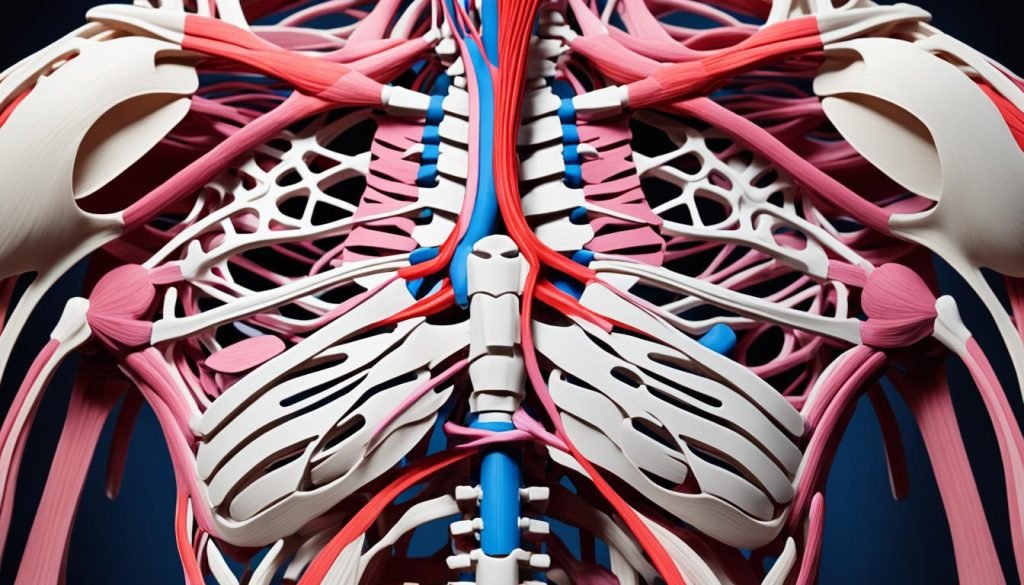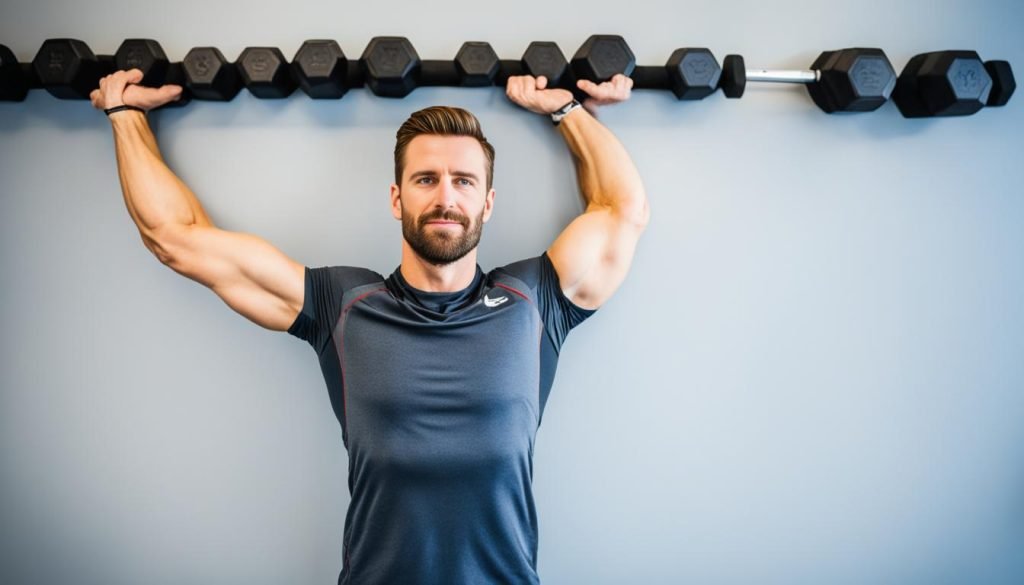Ever noticed how some gym-goers do great in their chest workouts while others don't see results? It might be because they focus on effective chest stretches. These stretches are key to boosting performance, increasing flexibility, and cutting down on injuries. We'll dive into why chest stretches matter, look at your chest muscles, and share stretches for before and after your workout. Get ready to change your routine and boost your gains with these essential exercises!
Key Takeaways
- Effective chest stretches are crucial for improving workout performance.
- Dynamic and static stretching techniques serve different purposes.
- Understanding chest muscle anatomy enhances your stretching effectiveness.
- Incorporating both pre and post-workout stretches can prevent injuries.
- A well-rounded stretching routine promotes better muscle recovery.
Importance of Stretching for Chest Day Workouts
Stretching is key for better performance and recovery during chest day workouts. It gets the chest muscles ready for hard work. This way, people can get the most out of their workouts.
Benefits of Dynamic & Static Stretching
Dynamic stretching is great for warming up muscles before exercise. It boosts blood flow, increases flexibility, and gets the body ready. The perks of dynamic stretching are:
- Improved range of motion in joints
- Reduced risk of strains and injuries
- Enhanced overall readiness for peak muscle performance
Static stretching is also beneficial, especially after a workout. It helps with muscle recovery and lessens soreness. The benefits of static stretching are:
- Promotion of muscle relaxation and recovery
- Increased overall chest flexibility
- Facilitation of better exercise form in future workouts
Enhancing Muscle Performance and Flexibility
Stretching regularly boosts muscle performance, especially by improving stability and coordination. Better chest flexibility means better form during exercises. This leads to safer and more effective workouts.
People who stretch both dynamically and statically see better muscle performance. They recover faster and gain more strength and size.
| Type of Stretching | Timing | Benefits |
|---|---|---|
| Dynamic Stretching | Before Workouts | Improved range of motion, enhanced blood flow |
| Static Stretching | After Workouts | Aids recovery, decreases soreness |
Understanding Chest Muscles Anatomy
The chest area is key for many physical activities. It has two main muscles: the pectoralis major and pectoralis minor. These muscles are crucial for strength and stability in different movements.
Pectoralis Major and Minor
The pectoralis major is the bigger muscle in the chest. It helps with pushing, lifting, and keeping the arm stable. The pectoralis minor is under the pectoralis major. It helps keep the shoulder blade stable and supports shoulder movement. Knowing about these muscles helps with training and avoiding injuries.
The Role of Chest Muscles in Functional Movements
Chest muscles are key for many functional movements we do every day and in sports. Activities like throwing, pushing, and lifting need the strength and flexibility of both muscles. Doing specific exercises and stretches can improve performance and lower injury risks.

Effective Chest Day Stretches to Include in Your Routine
Adding effective chest day stretches to your routine boosts performance and aids in recovery. These stretches get muscles ready for the workout and help them recover after intense training. Using both dynamic and static stretches is key for muscle health and top performance.
Dynamic Stretches for Warm-Up
Dynamic stretches are vital before starting chest workouts. They boost blood flow and warm up muscles, getting your body ready for the best performance. Here are some dynamic stretches to try:
- Arm Sweeps: Help open up the chest and shoulders.
- Floor Angels: Enhance shoulder mobility and promote stability.
- Torso Rotations: Improve flexibility and engage core muscles.
Adding these stretches to your routine is crucial for a strong start to chest workouts. They're a must for any chest stretching plan.
Static Stretches for Post-Workout Recovery
Recovery after a workout is just as crucial, and static stretches are key for muscle healing. They help reduce muscle tension and increase flexibility after a tough chest day. Here are some static stretches to try:
- Wall Chest Stretch: Provides a thorough stretch for the pectoral muscles.
- Foam Roller Pec Stretch: Targets tightness and promotes blood flow.
- Cobra Stretch: Opens up the chest and encourages better posture.
Adding these stretches to your recovery routine is crucial for muscle relaxation and adaptation. This is essential for long-term strength gains.
By focusing on both dynamic and static stretches, you can build a strong chest stretching routine. This routine supports muscle performance and recovery well.
Chest Day Stretches: Pre-Workout Techniques
Getting ready for chest day workouts is key. Foam rolling is a great way to loosen up and get moving better. It helps blood flow, setting you up for a strong workout.
Foam Rolling Techniques
Foam rolling is great for the chest muscles. Here are some tips to boost your pre-workout routine:
- Upper Chest Roll: Roll the foam roller across the upper chest to ease tightness.
- Sternal Release: Use the roller vertically on the sternum for deeper tissue work.
- Arm Positioning: Move your arms up and down while rolling to work your shoulders and chest.
Dynamic Stretches to Increase Blood Flow
Adding dynamic stretches to your warm-up boosts blood flow to your chest. Here are some stretches to try:
- Arm Circles: Make small to big circles with your arms to get your shoulder joints ready and warm up your chest.
- 90-90 Arm Sweep: Move your arms in a 90-degree motion to improve flexibility and get your pectorals ready.
- Torso Twists: Twisting movements work your core and chest, making you more flexible.

Using these pre-workout techniques can improve your performance and lower injury risk. Regular foam rolling and dynamic stretches make workouts better and more fun.
Post-Workout Chest Stretches for Recovery
After your chest workout, don't stop there. Adding post-workout chest stretches is key for muscle recovery. These stretches help relax the pectoral muscles, prevent soreness, and boost flexibility. They're vital for your body to recover well and get ready for the next workout.
Benefits of Cool Down Stretching
A cool down routine helps ease muscle tightness, cuts down on soreness, and speeds up recovery. Stretching after exercise helps get muscles back to their normal length. This makes post-workout chest stretches crucial for better movement and fitness performance over time.
Specific Static Stretches to Incorporate
Try stretches like clasping your hands behind your back or the bent arm wall stretch to cool down. These stretches stretch the chest muscles back to normal. Adding these stretches to your routine helps with muscle recovery and supports your fitness progress. Prioritizing post-workout stretches means you're looking after your long-term health.
FAQ
Why are chest day stretches important before a workout?
Chest day stretches are key because they boost flexibility and blood flow. They also get the pectoral muscles ready for hard work. This lowers the chance of getting hurt.
What are some effective dynamic stretches for warming up my chest?
Good dynamic stretches are arm sweeps and floor angels. They make the chest area more mobile and increase blood flow before exercising.
How can post-workout chest stretches aid in recovery?
After a workout, chest stretches like wall chest stretches and foam roller pec stretch help. They ease muscle tension, lessen soreness, and boost flexibility. This helps you recover faster.
What is the difference between dynamic and static stretching?
Dynamic stretching gets the muscles ready and boosts blood flow before exercise. Static stretching after workouts helps with flexibility and recovery.
Can foam rolling enhance my chest day performance?
Yes, foam rolling helps release muscle tension and improves movement. This can make chest workouts better and lower injury risk.
What role do the pectoralis major and minor muscles play in functional movements?
The pectoralis major helps with pushing and lifting. The pectoralis minor keeps the shoulder blade stable. This helps with shoulder function in different exercises.
How often should I incorporate chest day stretches into my routine?
You should do chest day stretches before and after workouts often. This improves flexibility, boosts performance, and prevents injuries.
What are common mistakes to avoid during chest stretches?
Don't overstretch, hold stretches too short, or skip warming up before dynamic stretches. These mistakes can cause problems.
Source Links
- 11 Chest Stretches for Warm-Up: Boost Your Workout Performance – https://www.dmoose.com/blogs/training/best-stretches-to-warm-up-before-a-chest-workout
- 10 Chest Stretches for Pre- and Post-Workout – https://steelsupplements.com/blogs/steel-blog/10-chest-stretches-for-pre-and-post-workout
- 12 exercises to tone your chest and improve posture – https://www.today.com/health/diet-fitness/best-chest-exercises-rcna22993
Recent Posts
It's important to evaluate whether Beachbody On Demand continues to meet your fitness needs as we enter 2025. With a range of workout programs and nutrition plans, the platform claims to cater to...
Just like having a personal trainer at your fingertips, Beachbody On Demand offers you an extensive library of on-demand workout programs accessible anytime, anywhere. This service allows you to...

